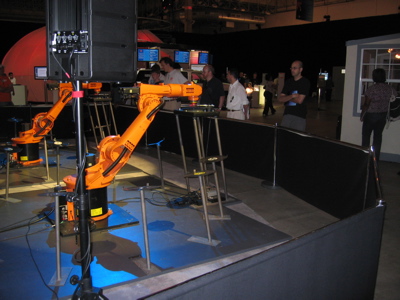
Report From Wired NexFest 2005
June 25-26, 2005
Chicago, Illinois
By Jonah Brucker-Cohen
In the sweltering heat of the Chicago summer, Wired Magazine’s NextFest took place on Navy Pier, the city’s entertainment center. Billed as “the next world’s fair”, the 2nd annual Next Fest (last year’s event took place in San Francisco and next year’s will be in New York City) was a mixture of corporate ecology culture and artistic interventions into visions of the future.
NextFest was split up into 7 categories examining projects in the future of “Exploration, Transportation, Security, Health, Entertainment, Design, and Communication.” Notable projects in this year’s fest included the “Entertainment” category’s “Kick Ass Kung Fu”, a full body Kung Fu game where participants step on a platform and fight 2D assailants. Camera tracking on movements puts players into the game screen. Other projects such as Robot Lab’s “Jukebots” were repurposed car manufacturing robots that spin and scratch records on turntables. It was nice to see a combination of hi-tech robotics next to the very “low-tech” medium of vinyl (especially since many of the kids attending the event might not even know what a “vinyl record” was. Also on the floor was “Musicbox”, a souped up version of the classic music windup toy where instead of metal pins, used bright LEDs On the subject of kids, the Future of Exploration pavilion featured “STINKY” a submersible robot built by the Falcon robotics team at Carl Hayden High School in Arizona. Their project was featured in WIRED in an article called “La Vida Robot”, as their hand-crafted robot beat MIT researchers in the “national underwater bot championship”. Nearby, in the “Transportation” pavilion, was the “Moller Skycar”, a flying car that looks like a 1950s red baron bomber. Videos playing beside it showed the car in action, but I have a feeling you have to be present at a test flight to really believe in it as the future of transportation.
The “Future of Health” pavilion was perhaps the most bizarre of all the collections of projects on display. Here you could see a set of real-live “cloned” cats. Also on display was Luminetx’s “Veinviewer”, an infrared light that when projected on the patient identifies which veins are suitable for injection or blood withdrawal. Also the “Power Assist Suit” by Japan’s Kanagawa Institute of Technology is a full-body hydraulic outfit that assists senior citizens or handicapped people by calculating how much air to release to the “muscles” based on sensor input from the wearer’s limbs. There was even a cyborg of Science fiction writer Phillip K. Dick that understood natural language enough for visitors to ask him questions. Unfortunately, I didn’t get a chance to ask what the next Hollywood inflated-budget remake of his novels would be? Oh well, maybe next time.
Across the room from Health was the “Future of Design”, which featured projects that attempted to seamlessly integrate technology into everyday experience. Sweden’s Interactive Institute showed their “Energy Curtain” an augmented curtain that stores energy from the sun on flexible solar panels during the day and lights up the opposite side at night. Also integrating technology into fabric was “Urban Chameleon”, a set of computationally enhanced skirts that monitored air quality, movement, and touch and displayed them on the surface of the garments.
Adding interaction into the mix, the “Future of Communication” featured projects that examined how technology will (and has already) change (d) the way we connect to people over distance and within close proximity. The “Acceleglove” by students at George Washington University, is a glove that translates sign language into written characters and speech to allow for a type of “dictation tool” for the deaf. Also here was “Mobile Feelings” by artists Christa Sommerer and Laurent Mignonneau. The project consisted of two gourds that that allowed each user to share their pulse rates with each other across a minimal distance.
Finally, the “Security” pavilion focused on projects that demonstrated how “secure” we might be if we had devices that could detect unwanted visitors from miles away and conduct automated background checks on them as they approached. One of the more interesting projects was “Brain Fingerprinting”, a device with electrodes that monitors brain activity and can detect when the person recognizes an image they had previously seen. Forget lie detectors, in the future nothing will be a secret.
As this year’s NextFest came to a close, the question remained as to how much of this “techno fetishism” stuff will ever make it to market? When will I be able to walk into my local car dealer and take a test “fly” in the Moller Sky Car? If the future is closer than we think, this might be something that will happen in our lifetime. If not, we might find out what’s “next” by dreaming it up in a bathroom stall. In any case, Wired’s world fair of sorts was a good reminder that we are heading towards the future at an accelerated pace. The question that still needs addressing is: What will we do once we get there?
-Jonah Brucker-Cohen
599 total views , 1 views today



